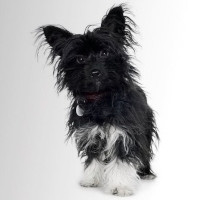 |
Skye-Pap |
|
He is not recognized by the F.C.I. |
Origin |
Great Britain <> France and Belgium -> U.S.A. | |
Translation |
Francis Vandersteen |
A brief presentation of the Skye-Pap |
| The Skye-Pap is a cross between the Skye Terrier and the Continental Toy Spaniel (Papillon). These little dogs have a lot of personality in a small space. Most of them measure just 20 to 28 centimeters and weigh between 7 and 10 kilos. Their coats are long and straight, and require moderate maintenance. The Skye Terrier and Continental Toy Spaniel are both popular pets, and the Skye-Pap hybrid has many of the characteristics of the parent breeds. These moderately energetic dogs adapt well to most environments and need a minimum of exercise. When properly socialized, they make excellent pets. However, due to their Terrier instinct, they can be prone to wandering. |
History of the Skye-Pap |
| Like most hybrid breeds, the Skye-Pap has an undocumented history. The breeds that make up this designer dog, however, have a long and well-documented history. |
A little of the Skye Terrier |
||
| The Skye Terrier was born in the 1600s. It was developed on the Isle of Skye in Scotland to hunt foxes, otters and badgers in their dens. It was bred to be fearless and compact, with powerful paws for digging and pursuing prey. During the 16th century, the breed became popular among English royalty. Queen Victoria acquired a Skye Terrier in 1842 and began breeding this much-loved pet in her royal kennels. The breed became popular with royalty and commoners alike, and one famous Skye Terrier, named Greyfriars Bobby, refused to leave his deceased owner's final resting place until his death 14 years later. The Skye Terrier was first recognized by the American Kennel Club in 1887, and today the breed is considered endangered. The breed's popularity has declined considerably, and it is quite rare in the United States. | ||
 |
||
| Standard of the Skye Terrier |
A little of the Continental Toy Spaniel |
| The adorable Continental Toy Spaniel was born in France in the 1500s. Descended from the Miniature Spaniel, it was bred to be a companion dog. Continental Toy Spaniels are also commonly bred and kept for show purposes. Although small in size, they are less fragile than they appear, and have plenty of personality. During the French Revolution, Marie-Antoinette is said to have carried a Continental Toy Spaniel under her arm on the way to the guillotine. The breed was first recognized by the American Kennel Club, and there are several groups and clubs devoted to these lively dogs. |
 |
| Standard of the Continental Toy Spaniel |
Appearance of the Skye-Pap |
| Like many mixed breeds, the Skye-Pap's appearance can vary considerably. These compact little dogs are often sturdier than they look. They have long, silky coats that can come in many colors, including black, gray, cream, fawn, blue, silver, sable, white, red and brown. Many have dark spots on the muzzle, ears and tip of the tail. The ears are usually large and erect, and usually heavily feathered. The eyes are dark and bright, and the muzzle is short to medium-length. Skye-Paps have black noses and long, straight tails with prominent feathers. The paws have thick pads and strong nails. |
Temperament of the Skye-Pap |
| Both the Continental Toy Spaniel and the Skye Terrier are known to be loving, affectionate and loyal to their masters. The Skye-Pap possesses all the best personality traits of the parent breeds and makes an exceptional companion. Because of their small size, they need to be socialized very early to avoid small dog syndrome. When properly socialized, they get on well with children, dogs and other pets. They are sometimes nervous of strangers and tend to bark. This is especially true when left alone. Skye-Paps are intelligent and relatively easy to train. However, like many small breeds, they often have difficulty toilet training. |
Needs and activities of the Skye-Pap |
| The Skye Terrier and Continental Toy Spaniel are both moderately active breeds. Because of their small size, they tire quickly and don't need as much exercise as the larger breeds. A few daily walks or runs, a trip to the dog park or a game of ball will be enough to keep your Skye-Pap happy and healthy. They also like to spend time exploring the outdoors, but their Terrier hunting instincts can make them prone to wandering. Skye-Paps are also highly intelligent and need mental stimulation. A puzzle is a good way to exercise your canine companion's brain. |
Maintenance of the Skye-Pap |
| The Skye-Pap's long coat requires moderate maintenance. These dogs tend to shed seasonally and need daily brushing to avoid tangles and knots. When kept as an indoor companion, they don't need to be bathed frequently. Use a mild shampoo and be sure to rinse well. When brushing or bathing, the skin should be inspected for sores or irritations. Like all dogs, they need regular nail trimming. Their ears should also be cleaned and inspected regularly. They also need their teeth brushed several times a week to prevent dental problems. |






 English (United Kingdom)
English (United Kingdom)